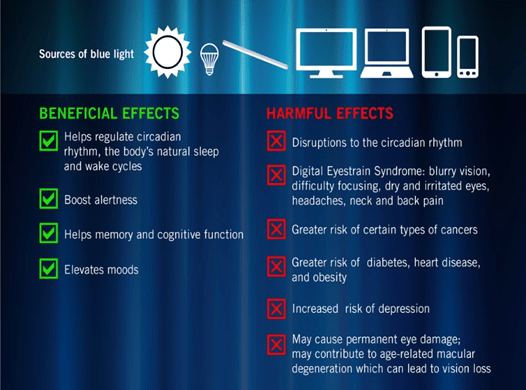Blue light exposure boosts attention through the day and suppresses the production of melatonin that helps you get to sleep at night. The lenses of these glasses filter out certain light waves emitted by the sun and digital devices like phones, laptops, and tablets. Even though it sounds like a perfect solution, recent studies have shown that it is not as effective as it claims to be. Doctors suggest switching off digital devices at least two hours before one goes to sleep.
Analysis
- Light is made up of electromagnetic particles that travel in waves.
- These waves emit energy, and range in length and strength.
- The shorter the wavelength; the higher the energy.
- The length of the waves is measured in nanometers (nm), with 1 nanometer equaling 1 billionth of a meter.
- Every wavelength is represented by a different color, and is grouped into the following categories: gamma rays, x-rays, ultraviolet (UV) rays, visible light, infrared light, and radio waves.
- Together these wavelengths make up the electromagnetic spectrum.
- However, the human eye is sensitive to only one part of this spectrum: visible light.
- Visible light is that part of the electromagnetic spectrum that is seen as colours: violet, indigo, blue, green, yellow, orange and red.
- Blue light has a very short wavelength, and so produces a higher amount of energy.
- Studies suggest that, over time, exposure to the blue end of the light spectrum could cause serious long-term damage to your eyes.
Natural blue light versus artificial blue light

- Blue light is actually everywhere. When outside, light from the sun travels through the atmosphere.
- The shorter, high-energy blue wavelengths collide with the air molecules causing blue light to scatter everywhere. This is what makes the sky look blue.
- In its natural form, your body uses blue light from the sun to regulate your natural sleep and wake cycles. This is known as your circadian rhythm.
- Blue light also helps boost alertness, heighten reaction times, elevate moods, and increase the feeling of well-being.
- Artificial sources of blue light include electronic devices such as cell phones and laptop computers, as well as energy-efficient fluorescent bulbs and LED lights.
Why should we be concerned about blue light exposure?
- Blue light waves are among the shortest, highest-energy wavelengths in the visible light spectrum.
- Because they are shorter, these “Blue” or High Energy Visible (HEV) wavelengths flicker more easily than longer, weaker wavelengths.
- This kind of flickering creates a glare that can reduce visual contrast and affect sharpness and clarity.
- This flickering and glaring may be one of the reasons for eyestrain, headaches, physical and mental fatigue caused by many hours sitting in front of a computer screen or other electronic device.
- Our eyes’ natural filters do not provide sufficient protection against blue light rays from the sun, let alone the blue light emanating from these devices or from blue light emitted from fluorescent-light tubes.
- Prolonged exposure to blue light may cause retinal damage and contribute to age-related macular degeneration, which can lead to loss of vision.
Daily exposure to blue light may accelerate aging
- New research suggests that the blue wavelengths produced by light-emitting diodes damage cells in the brain as well as retinas.
- Although light without blue slightly shortened the lifespan of an experimental organisms, just blue light alone shortened their lifespan very dramatically.
- Natural light is crucial for the body’s circadian rhythm — the 24-hour cycle of physiological processes such as brain wave activity, hormone production and cell regeneration that are important factors in feeding and sleeping patterns.
- But there is evidence suggesting that increased exposure to artificial light is a risk factor for sleep and circadian disorders.
- With the prevalent use of LED lighting and device displays, humans are subjected to increasing amounts of light in the blue spectrum since commonly used LEDs emit a high fraction of blue light.